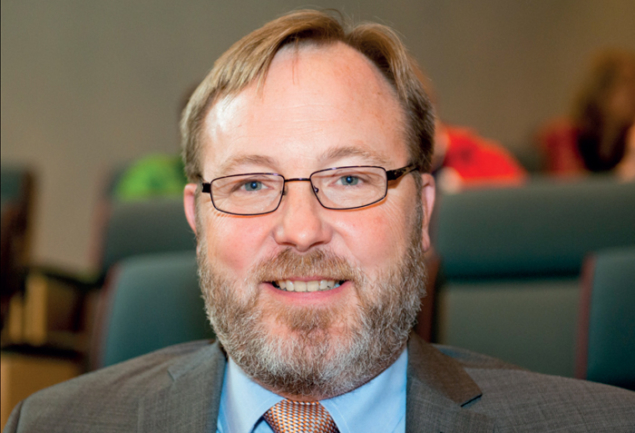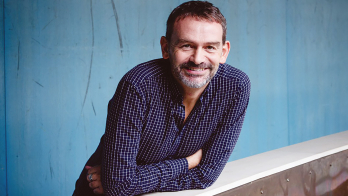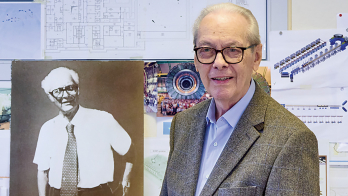The person in charge of constructing the ESS.

Image credit: ESS.
To paraphrase lines from the title song of a well-known film: “If there’s something big in your neighbourhood, who ya gonna call?” If the neighbourhood is particle physics, then it could well be Jim Yeck, who delights in seeing things built. This enthusiasm has underpinned his leadership of a number of successful big scientific infrastructure projects in the US, including the important US hardware contribution to the LHC and the ATLAS and CMS experiments.
Yeck’s first exposure to big science projects was as a graduate engineer in the late 1980s at the Princeton Plasma Physics Laboratory, where there was a proposal to build the $300 million Compact Ignition Tokomak. However, in 1989 the project was cancelled, because plasma ignition could not be guaranteed and the international ITER initiative was on the horizon. “It was a formative experience,” says Yeck, and instead of nuclear fusion, he found himself working on risk assessment for large science projects, which was to prove valuable for his future career.
In the autumn of 1990, he was asked by the US Department of Energy (DOE) to become the project manager for the construction of the Relativistic Heavy-Ion Collider (RHIC) at Brookhaven National Laboratory. Like its ancestor – the Intersecting Storage Rings at CERN – RHIC was built with two interlaced rings, but broke new ground by incorporating 1740 superconducting magnets, most of which were made in industry. Looking back, Yeck points out that the project was approved in a different era, “when you knew you had issues that you would have to work out later”. Basically underfunded, it was built against a background of tight budget constraints. “Such a project needs strong leadership, which we had in Nick Samios, the lab director, Satoshi Ozaki, the project director, and others,” he says.
Yeck remained with RHIC until the autumn of 1997, when the US was in the final stages of signing an agreement to contribute to building hardware for the LHC and the ATLAS and CMS experiments, and to become an Observer State of CERN. The DOE and the National Science Foundation (NSF) appointed him project director for this $531 million contribution, which comprised $200 million from the DOE for the LHC accelerator, and $331 million from the DOE and the NSF for ATLAS and CMS. At the time more than 550 US scientists from nearly 60 universities and six of the DOE’s national laboratories were involved.
“This was on the heels of the cancellation of the SSC [the Superconducting Super Collider] and the community recognized that it was imperative that the LHC should work and that the US should be part of it,” Yeck recalls. “People rallied together – it was beautiful.” There were to be many difficult issues to resolve and compromises to be made, but with a background in engineering rather than particle physics, Yeck had the advantage of being a clearly defined “enabler”, with no bias.
In late 2003, with the LHC’s progress on firm ground, Yeck moved on again, to become director of a rather different astroparticle-physics project. The IceCube Neutrino Observatory at the South Pole is not only at an exotic location with an international collaboration, it is run principally by the University of Wisconsin, and Yeck says that it interested him to show that a university can take on leadership of a large infrastructure project. IceCube was funded to the tune of $280 million, in this case mostly by the NSF, who had less experience of big projects than the DOE. There was also the interesting logistical challenge of constructing and operating the huge 1 km3 detector at the South Pole.
The old model of a country going it alone doesn’t work for such projects
Jim Yeck
During the long construction phase linked to summers at the South Pole, Yeck agreed to help launch construction of the National Synchrotron Light Source II back at Brookhaven, and served as deputy project director in the years 2006–2008. Then, 10 years after taking on IceCube, he made his latest change – to another kind of facility, another continent, and a different user community. In March 2013 he became chief executive officer (CEO) of the European Spallation Source (ESS), taking over from the first CEO, Colin Carlile.
The ESS will serve a research community dispersed across many fields of science, with potential users numbering in the thousands. “The old model of a country going it alone doesn’t work for such projects,” says Yeck. Instead, the ESS is furthering the approach of bringing many nations to work together, and with 17 partner countries it is approaching CERN in terms of the number of members. Using an analogy that should appeal to physicists, Yeck says: “CERN is an existence proof, and others have drawn on this. But the initial conditions have to be right.” When setting up rules for the governance of the new facility, ESS based many of the principles on those established 60 years ago for CERN.
Yeck’s experience has taught him what is important in making a success of such a project: “The facility has to be a priority for the scientific community”, he says. “If you don’t have that foundation, it’s a problem. Then you need commitments and a strong role from the facility host. And the leadership has to see itself as enabling the success of others.” A particular challenge of the ESS is that it is new in more ways than one – a new organization on a green-field site, much like CERN was in 1954. “Such an organization needs experienced people who can catalyse the successful efforts of many,” says Yeck. “We also have to establish realistic goals – it’s a case of putting experience over hope.”
The ESS management has been working hard during the past year on a realistic plan, which was reviewed in November by a committee of 33 members from a broad community, chaired by CERN’s Mario Nessi. Yeck learnt to appreciate the value of such reviews during his time in the US. “If you have problems, you can also seek collective ownership of solutions,” he explains. “And there will be problems. To pretend that you are not going to have them is a big mistake.” However, Yeck is a man who delights in seeing things built and the ESS is no exception. “It’s fantastically challenging, with contributions from many people,” he says, “but that’s what’s captivating.”





